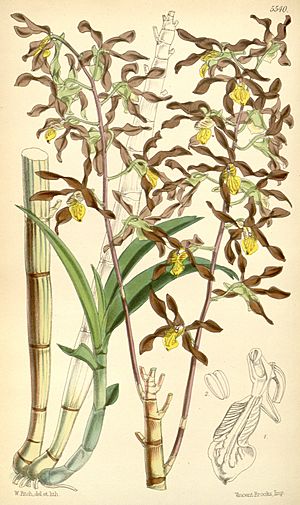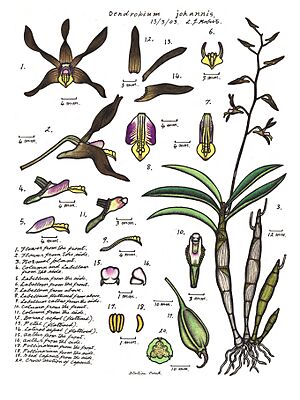Chocolate tea tree orchid facts for kids
Quick facts for kids Chocolate tea tree orchid |
|
|---|---|
 |
|
| Illustration from Curtis's Botanical Magazine | |
| Conservation status | |
| Scientific classification | |
| Genus: |
Dendrobium
|
| Species: |
johannis
|
| Synonyms | |
|
|
The chocolate tea tree orchid (scientific name: Dendrobium johannis) is a special kind of orchid. It grows on other plants or rocks, not in the soil. This type of plant is called an epiphyte or a lithophyte. You can find it in Australia and New Guinea. This orchid is known for its unique chocolate-brown flowers with a bright yellow lip.
Contents
What the Chocolate Tea Tree Orchid Looks Like
The chocolate tea tree orchid is a plant that doesn't have a woody stem. It has brownish or purplish parts called pseudobulbs. These pseudobulbs are like thick stems that store water. They are usually 10 to 30 centimeters (4 to 12 inches) long.
Leaves and Flowers
This orchid has between five and ten dark green leaves. They can be up to 20 centimeters (8 inches) long. The leaves often have purplish marks.
The orchid grows a flowering stem that is 10 to 25 centimeters (4 to 10 inches) long. On this stem, you can find six to fifteen flowers. Each flower is about 2.5 to 4.5 centimeters (1 to 1.8 inches) long. The flowers are a shiny chocolate brown color. They have a bright yellow part called a labellum, which is like a lip.
Flower Details
The flowers have thick, shiny parts called sepals and petals. These parts are often twisted. The sepals are about 2 to 2.5 centimeters (0.8 to 1 inch) long. The petals are similar in length but are narrower.
The labellum (lip) is about 1 to 1.6 centimeters (0.4 to 0.6 inches) long. It has three main parts, called lobes. The side lobes stand upright. The middle lobe curves downward and has three small ridges. These orchids bloom from March to July. They have a strong, but not very pleasant, smell.
How This Orchid Got Its Name
The Dendrobium johannis orchid was first officially described in 1865. A scientist named Heinrich Gustav Reichenbach gave it its name. He wrote about it in a magazine called The Gardeners' Chronicle.
Named After a Discoverer
The orchid was named after John Gould Veitch. He was an adventurous traveler who discovered many new plants. Reichenbach wanted to honor him. Since another orchid was already named Dendrobium Veitchianum, Reichenbach used John's first name, "Johannis," for this new orchid. This way, John Gould Veitch's contributions were still remembered.
Some people sometimes put this orchid in a different group called Cepobaculum. However, most scientists still agree that it belongs in the Dendrobium group.
Where the Chocolate Tea Tree Orchid Lives
The chocolate tea tree orchid grows in the Western Province of Papua New Guinea. In Australia, it is found from the very tip of Cape York Peninsula down to the McIlwraith Range and Coen.
Its Home Environment
This orchid is quite common in certain areas. It likes to grow in open forests, wet swampy places, and thickets that get a lot of rain during the monsoon season. You can find it at different heights, from about 50 to 600 meters (160 to 2,000 feet) above sea level.
Protecting This Special Orchid
The chocolate tea tree orchid is considered "vulnerable" by the Australian Government. This means it needs special protection. It is listed under the Environment Protection and Biodiversity Conservation Act 1999.
Main Threat
The biggest danger to this orchid is people collecting it illegally. This means taking the plants from the wild without permission. Protecting these orchids helps make sure they can continue to grow and thrive in their natural homes.



